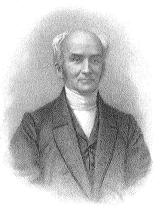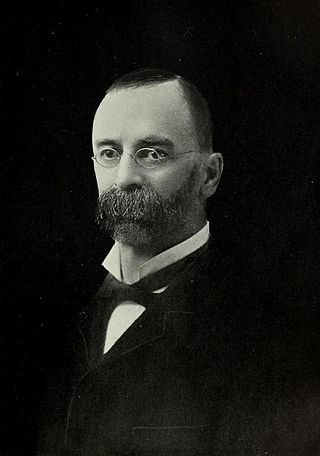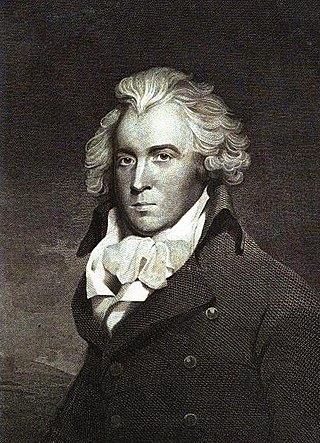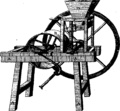
James Watt was a Scottish inventor, mechanical engineer, and chemist who improved on Thomas Newcomen's 1712 Newcomen steam engine with his Watt steam engine in 1776, which was fundamental to the changes brought by the Industrial Revolution in both his native country Great Britain, and the rest of the world.

John Smeaton was a British civil engineer responsible for the design of bridges, canals, harbours and lighthouses. He was also a capable mechanical engineer and an eminent physicist. Smeaton was the first self-proclaimed "civil engineer", and is often regarded as the "father of civil engineering". He pioneered the use of hydraulic lime in concrete, using pebbles and powdered brick as aggregate. Smeaton was associated with the Lunar Society.

Henry Thomas Colebrooke FRS FRSE FLS was an English orientalist and botanist. He has been described as "the first great Sanskrit scholar in Europe".
The year 1784 in science and technology involved some significant events.

Jesse Ramsden FRS FRSE was a British mathematician, astronomical and scientific instrument maker. His reputation was built on the engraving and design of dividing engines which allowed high accuracy measurements of angles and lengths in instruments. He produced instruments for astronomy that were especially well known for maritime use where they were needed for the measurement of latitudes and for his surveying instruments which were widely used for cartography and land survey both across the British Empire and outside. An achromatic eyepiece that he invented for telescopes and microscopes continues to be known as the Ramsden eyepiece.

John Farey Jr. was an English mechanical engineering, consulting engineer and patent agent, known for his pioneering contributions in the field of mechanical engineering.

Margaret Cavendish Bentinck, Duchess of Portland was the richest woman in Great Britain of her time, styled Lady Margaret Harley before 1734, Duchess of Portland from 1734 to her husband's death in 1761, and Dowager Duchess of Portland from 1761 until her own death in 1785.

Timothy Gilbert was an American piano manufacturer, abolitionist and religious organizer in Boston, Massachusetts. His brother Lemuel Gilbert was also a piano manufacturer.

A popcorn maker is a machine used to pop popcorn. Since ancient times, popcorn has been a popular snack food, produced through the explosive expansion of kernels of heated corn (maize). Commercial large-scale popcorn machines were invented by Charles Cretors in the late 19th century. Many types of small-scale home methods for popping corn also exist.

The single-grain experiment was an experiment carried out at the University of Wisconsin–Madison from May 1907 to 1911. The experiment tested if cows could survive on a single type of grain. The experiment would lead to the development of modern nutritional science.

Cavendish Square is a public garden square in Marylebone in the West End of London. It has a double-helix underground commercial car park. Its northern road forms ends of four streets: of Wigmore Street that runs to Portman Square in the much larger Portman Estate to the west; of Harley Street which runs an alike distance; of Chandos Street which runs for one block and; of Cavendish Place which runs the same. The south side itself is modern: the rear façade and accesses to a flagship department store and office block. On the ground floors facing are Comptoir Libanais, Royal Bank of Scotland and Pret a Manger premises.
Louis John Pouchée, was a London type founder and entrepreneur.

John Hick was a wealthy English industrialist, art collector and Conservative Party politician who sat in the House of Commons from 1868 to 1880, he is associated with the improvement of steam-engines for cotton mills and the work of his firm Hick, Hargreaves and Co. universal in countries where fibre was spun or fabrics woven.

James Cavanah Murphy (1760–1814) was an Irish architect and antiquary.
William Amos was a farmer, bailiff and estate steward who contributed through his inventions and published writings to the British Agricultural Revolution. He designed a number of improved agricultural machines and implements, and actively promoted more efficient farming techniques. His experiments and publications were widely discussed during his lifetime and continued to attract attention in the years following his death.
The London Electrical Society was established in 1837 to enable amateur electricians to meet and share their interests in “experimental investigation of Electrical Science in all its various branches”. Although it initially flourished the society soon showed weaknesses in its organisation and ways of working. After a period of considerable financial difficulty it closed in 1845.
Peter Atherton was a British inventor, entrepreneur, and cotton mill proprietor. Renowned for his pioneering work as a designer and manufacturer of textile machinery during the early Industrial Revolution, Atherton began his career by assisting Richard Arkwright and John Kay in developing the ground-breaking spinning frame in the late 1760s. Subsequently, Atherton developed methods to elongate cotton, wool, and silk fibres, resulting in stronger, smoother yarn and finer quality fabrics, representing a notable progression in textile manufacturing. His influence extended to mill construction nationwide, where his innovative designs and use of steam power marked significant advancements in industrial architecture. He engaged with policymakers and advocated for the interests of the British textile industry, notably participating in a delegation that met with Prime Minister William Pitt the Younger in 1788 to safeguard domestic production against the encroachments of the East India Company. Additionally, he established and invested in numerous enterprises within both the textile and clock and watchmaking industries. One of his companies, Atherton & Co., became a leading manufacturer of cotton spinners, with locations in Warrington, Manchester, and Liverpool.

Margaret Street is a street that straddles the Marylebone and Fitzrovia areas of the City of Westminster in the West End of London, running from Cavendish Square to Wells Street via Regent Street (A4201), Great Portland Street, and Great Titchfield Street. It is north of and parallel to the major shopping street, Oxford Street. John Prince's Street runs between Margaret Street and Oxford Street.
Edgar Corrie (1748–1819) was a Scottish merchant in Liverpool, a close associate at the end of the 18th century of John Gladstone.

















